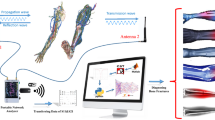Abstract
The aim of this study is to use a multilayer perceptron (MLP) artificial neural network (ANN) for phaseless imaging the human heel (modeled as a bilayer dielectric media: bone and surrounding tissue) and the calcaneus cross-section size and location using a two-dimensional (2D) microwave tomographic array. Computer simulations were performed over 2D dielectric maps inspired by computed tomography (CT) images of human heels for training and testing the MLP. A morphometric analysis was performed to account for the scatterer shape influence on the results. A robustness analysis was also conducted in order to study the MLP performance in noisy conditions. The standard deviations of the relative percentage errors on estimating the dielectric properties of the calcaneus bone were relatively high. Regarding the calcaneus surrounding tissue, the dielectric parameters estimations are better, with relative percentage error standard deviations up to ≈ 15%. The location and size of the calcaneus are always properly estimated with absolute error standard deviations up to ≈ 3 mm.

Microwave tomography of the calcaneus using phaseless data. Simulations were inspired in Computed Tomography images from real heels (above). Inverse problem was solved using Multilayer Perceptron Artificial Neural Network (below).







Similar content being viewed by others
References
Meaney PM, Zhou T, Goodwin D, Golnabi A, Attardo EA, Paulsen KD (2012) Bone dielectric property variation as a function of mineralization at microwave frequencies. Journal of Biomedical Imaging, 7
Sierpowska J, Lammi MJ, Hakulinen MA, Jurvelin JS, Lappalainen R, Töyräs J (2007) Effect of human trabecular bone composition on its electrical properties. Med Eng Phys 29(8):845–852
Irastorza RM, Blangino E, Carlevaro CM, Vericat F (2014) Modeling of the dielectric properties of trabecular bone samples at microwave frequency. Medical & Biological Engineering & Computing 52(5):439–447
Amin B, Elahi MA, Shahzad A, Porter E, McDermott B, O’Halloran M (2019) Dielectric properties of bones for the monitoring of osteoporosis. Medical & Biological Engineering & Computing 57:1–13
Pastorino M (2010) Microwave imaging. Wiley, New York
Meaney PM, Goodwin D, Golnabi AH, Zhou T, Pallone M, Geimer SD, Burke G, Paulsen KD (2012) Clinical microwave tomographic imaging of the calcaneus: a first-in-human case study of two subjects. IEEE Transactions on Biomedical Engineering 59(12):3304–3313
Li L, Zhang W, Li F (2008) Tomographic reconstruction using the distorted Rytov iterative method with phaseless data. IEEE Geosci Remote Sens Lett 5:3
Li L, Hu Z, Li F (2009) Two-dimensional contrast source inversion method with phaseless data: TM case. IEEE Geosci Remote Sens Lett 47:6
Costanzo S, Di Massa G, Pastorino M, Randazzo A (2015) Hybrid microwave approach for phaseless imaging of dielectric targets. IEEE Geosci Remote Sens Lett 12(4):851–854
Fajardo JE, Vericat F, Irastorza G, Carlevaro CM, Irastorza RM (2017) Sensitivity analysis on imaging the calcaneus using microwaves. arXiv:1709.04934.pdf
Franceschini G, Donelli M, Azaro R, Massa A (2006) Inversion of phaseless total field data using a two-step strategy based on the iterative multiscaling approach. IEEE Trans Geosci Remote Sens 44(12):3527–3539
Goodfellow I, Bengio Y, Courville A (2016) Deep learning. MIT Press, Cambridge
Heaton J (2008) Introduction to neural networks with Java, Heaton Research, Inc.
Bermani E, Caorsi S, Raffetto M (2002) Microwave detection and dielectric characterization of cylindrical objects from amplitude-only data by means of neural networks. IEEE Trans Antennas Propag 50(9):1309–1314
Wei Z, Chen X (2018) Deep-learning schemes for full-wave nonlinear inverse scattering problems, IEEE Transactions on Geoscience and Remote Sensing, IEEE
Li L, Wang LG, Teixeira FL, Liu C, Nehorai A, Cui TJ (2018) DeepNIS: Deep neural network for nonlinear electromagnetic inverse scattering, IEEE Transactions on Antennas and Propagation
Adams DC, Rohlf JF, Slice DE (2004) Geometric morphometrics: ten years of progress following the “revolution”. Italian Journal of Zoology 71(1):5–16
Fedorov A, Beichel R, Kalpathy-Cramer J, Finet J, Fillion-Robin J-C, Pujol S, Bauer C, Jennings D, Fennessy F, Sonka M et al (2012) 3D Slicer as an image computing platform for the Quantitative Imaging Network. Magnetic resonance imaging 30(9):1323–1341
Oskooi AF, Roundy D, Ibanescu M, Bermel P, Joannopoulos JD, Johnson SG (2010) MEEP: a flexible free-software package for electromagnetic simulations by the FDTD method. Comput Phys Commun 181:687–702
Bookstein FL (1997) Landmark methods for forms without landmarks: morphometrics of group differences in outline shape. Medical Image Analysis 1(3):225–243
Bookstein FL (1997) Morphometric tools for landmark data: geometry and biology. Cambridge University Press
James Rohlf F, Slice Dennis (1990) Extensions of the procrustes method for the optimal superimposition of landmarks. Syst Biol 39(1):40–59
Ruder S (2017) An overview of gradient descent optimization algorithms. arXiv:1609.04747
Kingma DP, Ba J (2014) Adam: a method for stochastic optimization. arXiv:1412.6980
François C et al (2015) Keras. https://github.com/fchollet/keras
Abadi M et al (2015) TensorFlow: large-scale machine learning on heterogeneous systems https://www.tensorflow.org/
Mosteller F (1971) The jackknife, Revue de l’Institut International de Statistique, 363–368
Acknowledgments
The authors would like to thank to Dra. Guadalupe Irastorza from Centro Diagnóstico MON, La Plata, Argentina, for the CT images.
Funding
This work was supported by a grant from the “Agencia Nacional de Promoción Científica y Tecnológica de Argentina” (Ref. PICT- 2016–2303) and from the “Universidad Nacional Arturo Jauretche” (Ref. UNAJ Investiga 2017 80020170100019UJ).
Author information
Authors and Affiliations
Corresponding author
Additional information
Publisher’s note
Springer Nature remains neutral with regard to jurisdictional claims in published maps and institutional affiliations.
Rights and permissions
About this article
Cite this article
Fajardo, J.E., Lotto, F.P., Vericat, F. et al. Microwave tomography with phaseless data on the calcaneus by means of artificial neural networks. Med Biol Eng Comput 58, 433–442 (2020). https://doi.org/10.1007/s11517-019-02090-y
Received:
Accepted:
Published:
Issue Date:
DOI: https://doi.org/10.1007/s11517-019-02090-y




